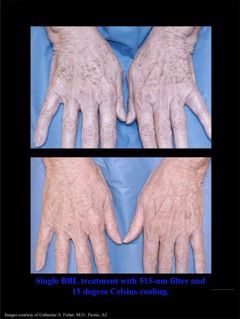Age Spots
If you are close to 40, you are probably starting to see a few dark spots appearing that don’t quite fade away like they use to!
Age spots (also called liver spots, sun spots, or solar lentigo) most commonly appear on the back of hands but can occur almost anywhere on the skin, especially the sun exposed areas such as the face, shoulders, neck, chest, and legs.
How do we get them?
Most of the cells in the epidermis (skins surface layer) are cells that form the dead skin layer as well as keratin (protein) that protect us from the outside world. Age spots are superficial collections of melanin (a pigment that gives color to the skin) that have accumulated on the top surface of the skin. One in every tenth or twentieth cell is a melanocyte which produces melanin pigment and transfers this brown pigment to our skin cells which protect us from the sun. Some people don’t have as much melanytes as other people and that is why some people don’t tan as well as others.
When we are exposed to the sun our bodies produce melanin to help protect the deeper layers of the skin which is why our skin turns brown or tanned. As we age, our skin’s natural ability to fend for itself seems to deteriorate.
Are they Freckles?
Some patients will mistake age spots for freckles (ephiledes). Freckles are flat brown round spots (about the size of a common nail head or pencil head), and are usually in younger patients with fair skin. Freckles are more numerous in the summer but, tend to fade with age; it’s also an inherited characteristic. Age spots are the result of a ceroid pigment build up (which is when extra melanin becomes clumped or is produced in higher concentrations than normal). It’s the same as an injury to the skin, like the same way a scar is formed from a cut. Freckles fade after summer but, Age spots do not fade away and they get worse with age. Dark spots can be caused by a burn or from sun exposure over a period of time.
Are they dangerous?
Age spots are flat harmless patches of skin, which vary in size from as small as a freckle to as large as more than an inch in diameter. Color can be brown, brownish yellow, brownish red, or even grey-blackish. If you are unsure about it being an age spot, a freckle, or see change in shape or color make sure you consult with a physician or medical aesthetician. They are used to seeing these spots on a regular basis and will know if it looks abnormal or if you need a biopsy. Age spots do not itch and are not painful but, they are not very attractive and they do tell our age.
How can I get rid of age spots?
There are several different treatments that help fade or rid these unattractive spots; kojic acid, chemical peeling, prescription bleaching creams, IPL lasers , BBL lasers that use bands of light, erbium lasers (burn) and, cryotherapy (freezing). My favorite way to remove age spots is by using a broad band light laser. It seems to be the most effective method with the least amount of healing time and I have had very good results.

